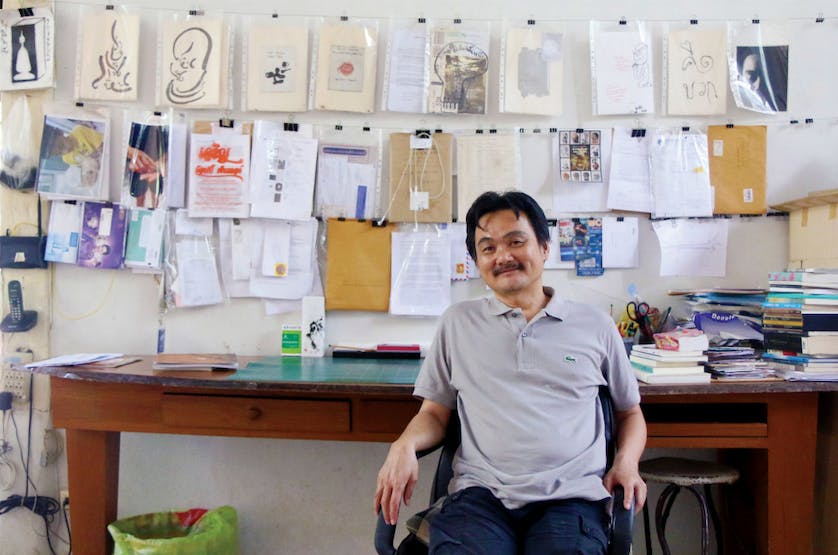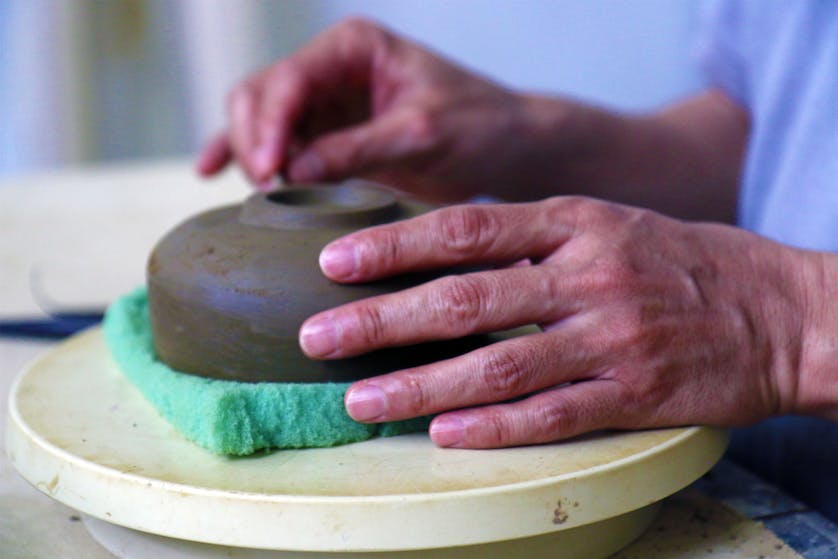Kamin Lertchaiprasert is making a bowl in his art studio. He has made dozens before, the same as this one. When he finishes he will place it to dry with the others and make another, and after that, another one. As he smooths its edge with a wooden rib while rotating the tiny pottery wheel, lost in the repetitive task, Kamin conducts more of what he calls research.
“I try to understand how the present moment exists,” Kamin explains calmly in the English he’s acquired by traveling the world with his art. “I observe myself while making a bowl, and I try to develop an understanding. How do I relate to this skill? How much do I understand of my own experience? I try to understand everyday life.”
I think, I kind of see what Kamin is getting at, but I’m not entirely sure, and Kamin can tell.

“Do you see that painting?” Kamin asks, motioning to a large canvas mounted to the wall behind me. It is a painting in progress; a depiction of a scene captured in a photograph Kamin took on his first trip to Chicago. A print out of the photo is masking taped to the canvas; a scene of two friends in a café looking out onto the street. Kamin took the photo from outside looking into the café, and the two friends are pressing a piece of paper against the window pane. It’s a message to Kamin, in big bold letters scratched in pen, the paper reads “HAVE A GOOD NIGHT!” In the painting, portions of the scene seem completed, while other sections are only outlined in pencil on the naked white surface of the canvas.
“Do you understand how this is the present moment?” Kamin asks.
“I think, it’s about, surprise?” I say. “Spontaneity? So, something that caught you off guard and you captured it, so you captured that moment.”
“No, that’s not what it’s about,” Kamin replies flatly, our photographer and I chuckling at my earnest failure.
Kamin smiles, seeming satisfied that he’s fooled another observer. “It’s finished. Most people don’t understand that it’s finished. It is finished. It is finished but it’s not finished, but it’s finished. It’s just there.”
Woah.
Kamin has an incredible talent to identify and explore the abstract elements of life through his art; art that requires tremendous discipline and long spans of time devoted to dwelling in the element of his choosing. It’s, well, hard to describe. Kamin’s focus on the present moment is just his latest devotion to the deconstruction of life. He will spend years yet attempting to gain the understanding he aims to achieve, and then communicate what he has learned through his artwork.

Kamin, born in 1964 in Lop Buri Thailand, studied art at Silpakorn University and later moved to New York City to work and study print-making. He returned to Thailand, and spent time as a Buddhist monk, a period that can be reflected in his calm and poised presence, and the diligent and focused approach he takes to his art as he strives to understand man’s relationship with himself and the outside world.
Kamin works in a variety of mediums including painting, sculpture, installation, video, performance and print making. Kamin’s art has been exhibited all over the world and incorporated into permanent collections in Norway, Singapore, Thailand, Australia, and the Guggenhein in New York City. Kamin is the cofounder of the Land Foundation (an experimental art community in San Pa Tong) and founded the 31st Century Museum of Contemporary Spirit next to his home in Chiang Mai, where he has lived and worked for the last twenty years.
For the last five years, Kamin has welcomed the people of Chiang Mai to experience the 31st Century Museum of Contemporary Spirit; a record of his previous research.
The idea for the 31st Century Museum began in Kanazawa Japan, where Kamin was invited to participate in a conference at the Kanazawa 21st Century Museum of Contemporary Art. After the conference, he was asked to create a site-specific work for the museum. Kamin agreed, and began to explore Kanazawa for inspiration.
While exploring the city, Kamin made a stop at an elementary school, and met the headmaster. While they talked, the headmaster was busy filling out certificates for every student. He explained that he fills them out every year and includes one positive trait for each student. This year there are over 500. Kamin was inspired by this; that a man could find goodness in 500 different students, and find a specific positive trait in each one. This was especially significant to Kamin, because while Kamin was in elementary school he was awarded the “bad kid” award, which labelled him as the worst-behaved student in his school.
Kamin told the headmaster this, and the headmaster wrote out a certificate for Kamin, which read “everyone has at least one good thing in oneself.”
The importance of the headmaster’s certificate to Kamin gave him the idea for his first 31st Century exhibition held at the 21st Century Museum of Contemporary Art in Kanazawa.
“The idea was kind of teasing the institution. Museums are based on objective knowledge. Something happened, something was created, and it should be regarded as valuable. My idea was to focus on subjective value, an inner value that exists in everyone and that can only be found in certain things.”
To explore this idea of subjective value, or what Kamin likes to call “spirit,” he formed an exhibition that displayed objects contributed by people from the community that had special value to them; objects like Kamin’s new, cherished certificate.
Over 200 objects were gathered for the project; a music box, a pair of pajamas, a djembe drum, a stereo set– every object paired with a story that gave the items tremendous value.
“I wanted to gather this positive energy, it became an art form in itself. I don’t know what to call it exactly: positive energy- maybe you call it love, or care, or something like that. But I made up the concept for this next-century museum, where everyone is a walking museum.”
“After I came back from Japan, for about two years I tried to understand this more, and that’s when I made the 31st Century Museum of Contemporary Spirit; it’s a research station devoted to understanding this positive spirit as art.”
The museum, set in the wooded area on the southern side of Chiang Mai University off of soi Wat Umong, is a cleverly designed cluster of shipping containers exhibiting pieces from artists local and international that Kamin believes possess this spirit. Hair braided into flowers, an ancient scroll, Japanese wood prints, and other works paired with stories that add a value that transcends the physical and enters into something else- yes…spirit, we’ll call it.
But Kamin’s contract for the land only included five years, and his five years are up. Kamin passes me a large blue-print with models of the new 31st Century Museum. It will reuse the same shipping containers, but they will be reconfigured and connected via walkways and staircases. The layout is more fluid, and reflects a more cohesive plan versus the original design.
“I’m moving them to my back yard,” explains Kamin. “I’m expanding the museum to include records of my other projects from Chicago and other areas. And all of the bowls I’m making will go in the new tea room.”
The 31st Century Museum of Contemporary Spirit is still open to the public, and all are welcome to pay a visit and be received by any of the museum attendants, such as Maw, who greeted us warmly and led us around each container to describe the pieces and explain why they were chosen as part of the collection.
Soon, the museum will be dismantled and relocated, so it’s best to visit the 31st Century Museum of Contemporary Spirit while you still can. But as we left Kamin in his studio, the sunlight illuminating his workspace as he patiently worked the clay of another bowl, he didn’t seem to be in any hurry.
The 31st Century Museum of Contemporary Spirit
100/6 Moo 10, Soi Wat Umong 11, Suthep Rd
Facebook: 31century
